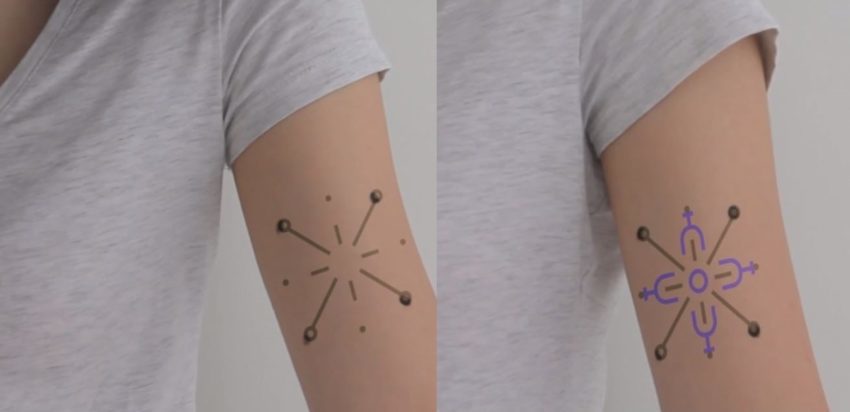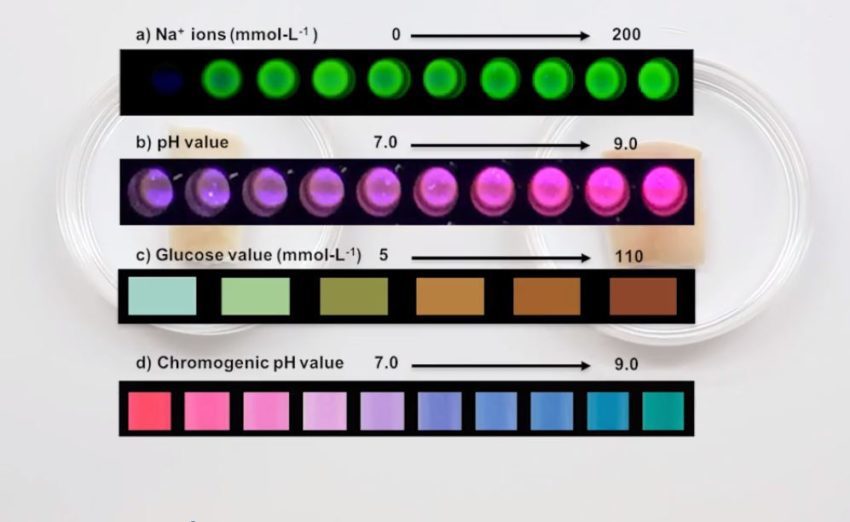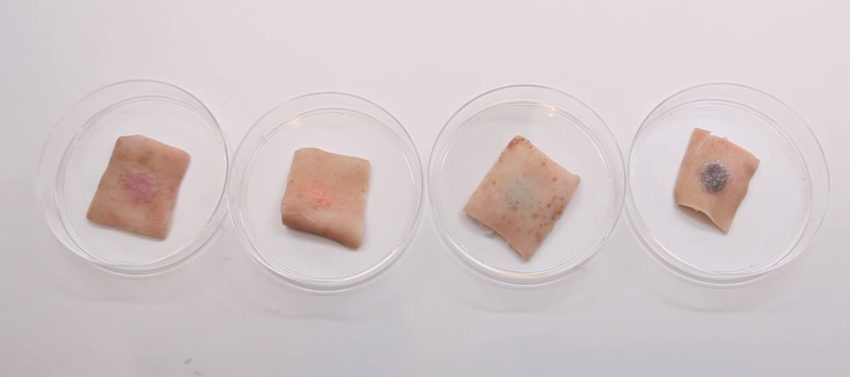The Dermal Abyss (d-abyss) is a project currently under development by Harvard Medical School researchers Ali Yetisen and Nan Jiang and by MIT researchers Katia Vega, Xin Liu, Viirj Kan and Nick Barry. The d-abyss renders the body’s surface as an interactive display by patterning biosensors into the skin to produce color changes in response to biomarker variations – including sodium, glucose, and pH – in the interstitial fluid. D-abyss is the perfect combination of biotechnology and tattoo artistry and is designed to use the aesthetics, permanence, and visible nature of tattoos to encode relevant information.
In the study, the researchers replaced the traditional ink used in tattoos with colorimetric and fluorescent biosensors. Today as we speak with Dr. Nan Jiang – who is currently a Postdoctoral fellow at the School of Engineering and Applied Sciences at Harvard University and has been working as a postdoc at Harvard Medical School for two years undertaking research on nanobiotechnology and biosensors – she will share with us the most significant facets of the team’s research project. If you would like to learn more about tattoos visit thetattoogeek.com.

In the Photo: Rendering on how the D-Abyss could work. Photo Credit: Dr. Nan Jiang.
One interesting aspect of d-abyss is the background of the people involved. Dr. Nan Jiang notes: “In this project, MIT brings experts of wearable technology while Harvard brings the medical people.”
Silicon-based implantable sensors and electronic wearables could be an alternative to d-abyss, but they both have issues: silicon-based implantable sensors are not fully biocompatible and they may cause discomfort. Wearables, if put in direct contact with the skin, can collect a significant amount of data, but as Dr. Nan Jiang explains they bring up some issues. “They can collect and monitor, but it is always necessary to use a device externally to check them.” Other issues include higher costs, battery recharging, and the incompatibility between solid-static and soft body tissue. Also, as mentioned in their research paper, “wearable biosensors, while being safe and easy to develop, could suffer from a lack of direct access to the compartments in the body containing the relevant biomarkers”.
All those issues could be solved by d-Abyss. Changes in the skin’s color already show diseases, emotions and even nutrition. According to this research, “by tattooing optical biosensors that can react with changes of the interstitial fluid and show changes in color, light intensity, or structure of the tattoo, it is possible to display information and detect changes in physical parameters and biomarker concentrations in the human body”. With one great advantage: d-abyss has the access of an implantable biosensor but the interactivity of a wearable device. It could be decoded by the user, other viewers, cameras or “even an app could be developed to decode d-abyss” says Dr. Jiang.
Further integration of optical technologies within the skin may allow the camouflage of the tattoo or highlighting the information dynamically. Another advantage highlighted by Dr. Jiang is the fact that “D-abyss does not require electrical power or recharging, it is located inside of the skin making it permeable and insulated, and body movements, postures and stretches in skin will not affect its connectivity. If this works and is developed it could help people with diabetes. Diabetic people, especially those with Type-1 diabetes, called us to be tested because they are tired of using needles, and d-abyss could really be helpful for them”.

In the Photo: A possible color palette of the the D-Abyss. Photo Credit: Dr. Nan Jiang.
While normally tattoos are associated with a desire for self-expression, uniqueness, and personal style, and are one of the oldest body modification processes, there are also tattoos that are used for functional reasons, such as ensuring the location of reported radiotherapy applications, identifying blood types, scar camouflage and medical identification for conditions requiring special attention. An integration like the one proposed in the d-abyss project is attractive because the “integration of tattooing and biosensors could create new diagnostics methods, [and] human-machine interaction interfaces”. As Dr. Jiang explains, “d-abyss can enable users to extend the function of self-expression and aesthetics of tattoos beyond personal representation, into a new medium advocating self-care and healthfulness”.
The d-abyss has been tested first in vitro and then on ex vivo pig skin, but it will still take quite sometime before it could become a standard practice on humans. Further studies regarding the toxicity of biosensors and their interference with normal tissues functions should be done, especially in the long term.
Tattooing biosensors on the skin for applications in medical diagnostics could have numerous applications in the future, and Dr. Jiang calls for interest in this area by other researchers: “If there are people interested in our project, we would like to meet and cooperate with them, especially if they could help us move forward. We envision a future with partnerships between biotech companies and skin professionals such as prosthesis experts and tattooists in order to embrace the idea of human-device symbiosis.”

In the Photo: The D-Abyss applied on pig skin for research. Photo Credit: Dr. Nan Jiang.
Considering the d-abyss could be used by a wide range of people, from recreational and professional athletes to astronauts – making their lives much more convenient for the purposes of monitoring relevant biomarkers – there is significant potential in this space. While a future where people will incorporate devices in their bodies like cyborgs seems to be a distant reality, the d-abyss project shows that a simple – but smart – form of body art could truly pose a significant breakthrough in the near future. Twelve percent of Europeans have tattoos, while 24% of Americans do – could many of those have d-abyss on their body in the future? The answer is yet unknown, however d-abyss demonstrates to us that practicality and artistry are not always in contrast.









